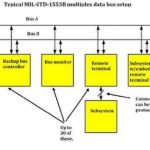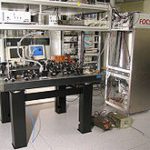Enormous gains have been made in quantum research by confining single atoms or small numbers of atoms and elementary particles in electromagnetic traps. For experimental purposes, what is wanted is the ability to confine a single particle in a small container for a long time. The object would be to repeat measurements introducing alternate variables so as to eliminate possible errors. Two varieties of traps are the Paul RF trap and the Penning trap.
A Paul trap uses direct current in conjunction with radio frequency fields to trap ions. They are held in place by means of a pair of hyperbolic metal electrodes, the foci facing in toward the area of confinement, and a hyperbolic ring electrode that is situated between them. Oscillating and static electric fields prevent the ions from leaving the area. Frequently, a Paul trap is built into a mass spectrometer.
Penning traps are also effective in confining charged particles. Traditionally these devices have been used to trap ions and subatomic particles so that their properties can be precisely measured. A recent application is to isolate and retain qubits in pursuit of a working quantum computer.
All ion traps confine the motion of charged particles using electric and magnetic fields. Point charges can’t stay in a stable stationary equilibrium just by electrostatic interaction of the charges. (The applicable law of physics is called Earnshaw’s theorem.) The point of an ion trap is thus to create a saddle point in the potential using electromagnetic fields at just the right frequency and voltage. In the simplest case, a quadratic potential is created using three electrodes.

The Penning trap makes use of a static quadratic potential-well along the axis joining its two endcap electrodes (the z-axis). This is created by putting a positive potential (V) on the endcaps relative to the ring (for positively charged particles). The resulting simple harmonic motion in the axial direction has an angular frequency of ωz = (4qV/md2)1/2, where q and m are the charge and mass of the ion respectively and d is a distance related to the separation of the endcaps (2z0) and the diameter of the ring electrode (2r0) by the equation d2= r02+ 2z02. Typical values of d range from a few millimeters to a few centimeters.
The potential in the radial plane also varies quadratically as a function of x and y, but the potential has a maximum at x=y=0, making the radial motion unstable. This is overcome by applying a strong magnetic field along z. The magnetic field gives rise to a cyclotron-type motion (accelerating outwards from the center along a spiral path) of the ions at an angular frequency close to ωc = qB/m, which is the normal cyclotron frequency (the frequency of a charged particle moving perpendicular to the direction of a uniform magnetic field) for a particle moving in a magnetic field of magnitude B. Its value is shifted down slightly by the presence of the radial electric field, which also gives rise to a second, slower, circular motion in the radial plane called the magnetron motion (at an angular frequency ωm).

Penning traps have been used for many different types of experiment, often using high magnetic fields in the range of 1–10 Tesla from superconducting magnets. For trapped electrons, this gives cyclotron frequencies up to tens of gigahertz. For protons, the cyclotron frequencies are in the range of tens of megahertz, and for singly charged atomic ions they are typically on the order of 1 MHz. Space charge limits the maximum number density of particles in the trap to values of the order of 108– 109 cm-3 for atomic ions.
A future is foreseen when light rather than electricity will become the preferred medium for microprocessors in many if not all applications. But realization has been problematic. How do you immobilize light? A photon that is not going anywhere seems to be a contradiction in terms.
Photons are quantum particles that represent one aspect of light, the other being electromagnetic radiation propagated in the form of waves. Traditionally it was thought that photons could only be captured at very low temperatures. A way to capture and confine light energy at room temperature is now considered viable. The process involves causing the photons to coalesce into a large wave known as a Bose-Einstein Condensate.
In the past, BEC as it is known, was found to be a state of matter consisting of a dilute gas of bosons cooled close to 0 degrees K. At this point, many of the bosons occupy the lowest possible state, exhibiting quantum properties.
Bosons, particularly photons and helium-4, share a common quantum state. The idea was proposed by Satyendra Nath Bose and refined by Albert Einstein in 1924-1925.
It happens that light is anomalous in the sense that it can become a BEC at room temperature. About five years ago, physicists at Bonn University in Germany were able to condense photons between two mirrors that were in close proximity. Unable to escape, the photons were quite literally trapped.
The phenomenon may turn out to be a key concept in the development of working quantum computers and there are implications that may provide the much-needed breakthrough in PVC technology.






Leave a Reply
You must be logged in to post a comment.